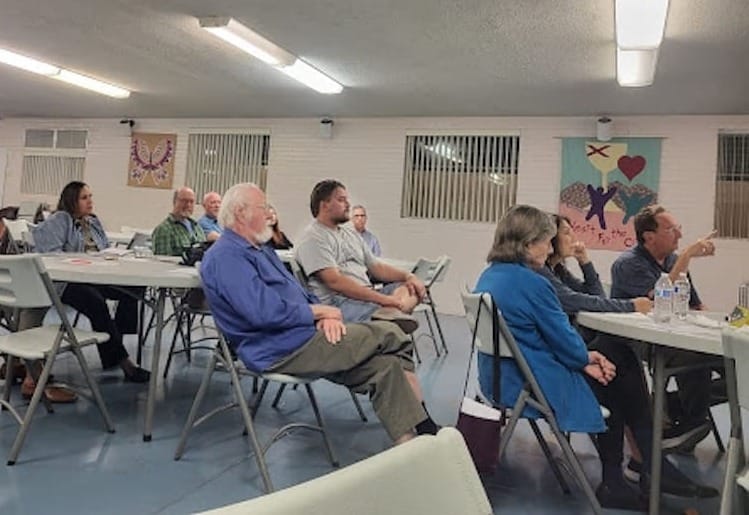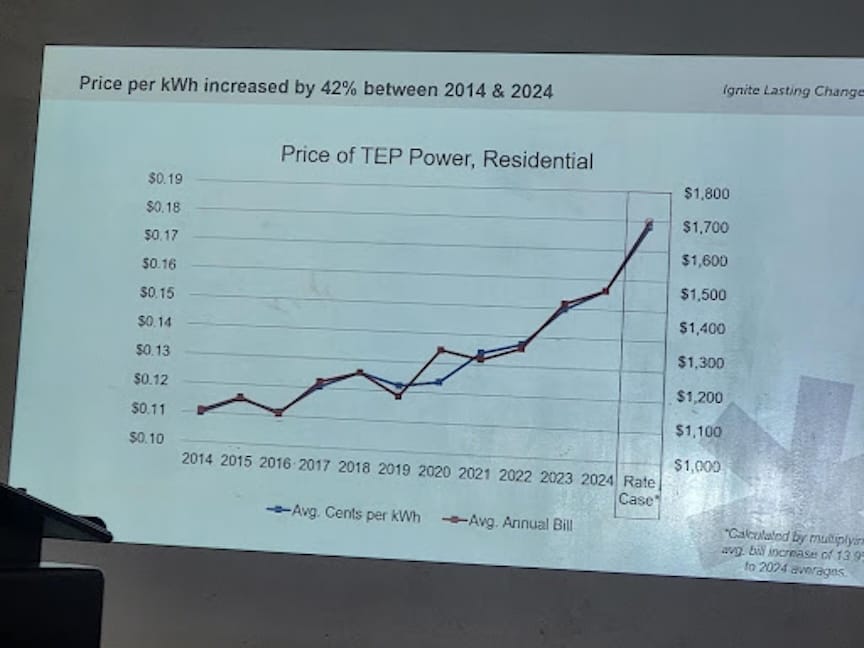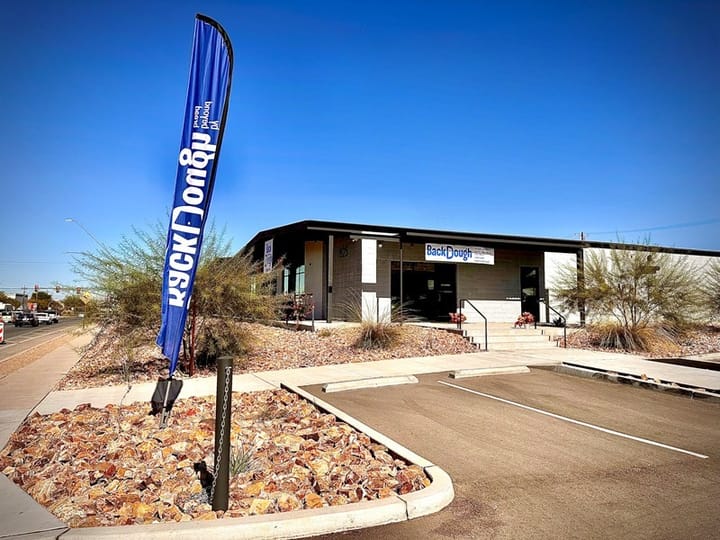Tucson residents push back on TEP’s proposed rate increase
At a packed town hall, Tucson residents questioned TEP’s proposed 14% rate hike while consumer advocates warned the increase and new formula-rate system would disproportionately harm low-income households.

As Tucson Electric Power seeks permission to raise customer rates by 14%, residents packed a town hall earlier this month to question the utility’s proposal, learn how the increase could affect their monthly bills and hear from advocates who say the change would hit low-income households the hardest.
If approved, the new TEP rates would take effect in September 2026. For a customer on TEP’s basic pricing plan who uses an average amount of electricity, the increase would be about $16 per month, though individual bills would vary.
TEP said the rate hikes are necessary to account for inflation and interest rates, as well as $1.7 billion in infrastructure investments.
The current rates went into effect in 2023, and surcharge reductions in 2024 and 2025 lowered the average customer’s bill by $10 and $4, respectively, due to lower energy costs.
The $1.7 billion in infrastructure spending includes $429 million for distribution projects such as new substations, $354 million for generation, $350 million for a new energy storage facility, $329 million for transmission and the remainder for software and facility upgrades.
The Arizona Corporation Commission allows investor-owned utilities to adjust rates to recover infrastructure costs and earn a return on those investments.

Cynthia Zwick, director of the Residential Utility Consumer Office, told attendees that the commission last year gave utilities the option to use formula rates for the first time, allowing them to propose a formula to calculate rates on an ongoing basis.
“Customers pay more in states with formula rates. Mostly the southeast is where formula rates have been authorized, and customers consistently pay more than they did under the historical structure,” Zwick said. “Every year, your rates are likely to go up.”
Zwick added that she believes the approval process was too fast and said her team is challenging the decision in the Court of Appeals.
The commission approved formula rates to improve the regulatory process, reduce under- or over-recovery, provide a guaranteed return, eliminate frequent rate cases and allow for gradual adjustments instead of “rate shock.” Officials say gradual increases will be easier for customers to budget for.
Kelly McGowan, executive director of Wildfire AZ, told attendees that in the past 12 months, 21% of Arizonans were unable to pay their energy bill in full at least once, 27% kept their homes at an unsafe temperature and 36% cut back on other necessities to pay their bills.
McGowan said an inability to pay energy bills is strongly correlated with eviction. Low-income households spend a much larger share of their income on energy — in some cases as much as 25% more per square foot — due in part to poor weatherization. She said this means rate increases will hit them disproportionately.
To address that, TEP offers a weatherization program and payment assistance for qualifying customers.

McGowan said she supports TEP’s effort to adopt a tiered discount program that increases bill reductions as income decreases. Under the proposal, households between 101% and 200% of the federal poverty level would receive a 20% discount, while those at or below the poverty level would receive a 50% discount.
Diane Brown, executive director of the Arizona Public Interest Research Group, urged residents to take action on the rate case by writing letters to the commission, posting on social media and signing petitions. She noted that TEP sought a $150 million increase during its last rate case but received only a portion of that and still operated successfully, a result she attributed to community advocacy.
TEP spokesperson Joe Barrios attended the meeting and said he believed it “went great.”
“When we file an application for new rates, we recognize any impact on customers,” Barrios said. “It can really affect their pocketbooks and there’s a lot of concern in the community about rising costs and I think forums like this are important.”
Barrios encouraged customers to contact TEP if they need help paying their bills or want more information about assistance programs, including payment extensions or payment plans, and to ask questions about the rate request.
“Regardless of what the presentation was about, I think the folks that were in attendance want to see a lower rate, and I think that entails action at every level that supports our residents and really living within the costs of our own needs,” Ward 5 Councilman Rocque Perez told Tucson Spotlight. “Right now, what we see at TEP doesn’t allow for that.”
Barrios said the proposed 14% increase still falls short of the company’s 15% increase in costs due to inflation between December 2021 and April 2025.
“We work very hard to keep customer bills as low as possible by managing rising costs for equipment, parts, construction materials and other necessities,” Barrios said.

Town hall attendee Bruce Plenk said he appreciated the chance to meet with officials in Tucson instead of having policy discussions take place exclusively in Phoenix. He said he was concerned about TEP using automatic formula rate increases.
“I think TEP is going to have a hard time justifying the rate increase,” Plenk said. “There was plenty of discussion tonight about some problems with it. It’s going to be interesting to see how it goes.”
Another attendee, Russell Lowes, said he believes investor-owned utility structures can incentivize companies to act against customer interests. He argued that Tucson or Pima County would benefit from adopting a community choice aggregation model, which would allow local governments to procure power on behalf of residents.
“TEP doesn’t want to do energy efficiency on any kind of grand scale because it cuts down their power sales. It’s inherently not in their interests,” Lowes said.
He noted that 10 states use community choice aggregation, and some — such as Peninsula Clean Energy in California’s Bay Area — have reached 100% renewable energy for their entire grid within nine years. He said Tucson could move even faster due to Southern Arizona’s ideal solar and wind conditions.
TEP projects that it will reach 58% solar and wind generation by 2038.
Communities nationwide have seen energy rates rise due in part to large data center projects from companies like Amazon. TEP is seeking approval for an Energy Supply Agreement for the Amazon-backed Project Blue data center, but said the agreement is unrelated to the current rate increase request, which is based on historical costs rather than future spending.
However, if formula rates are approved, they could allow the company to raise rates later to account for infrastructure investments connected to such projects.
Ian Stash is a journalism major at the University of Arizona and Tucson Spotlight intern. Contact him at istash@arizona.edu.
Tucson Spotlight is a community-based newsroom that provides paid opportunities for students and rising journalists in Southern Arizona. Please consider supporting our work with a tax-deductible donation.



